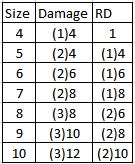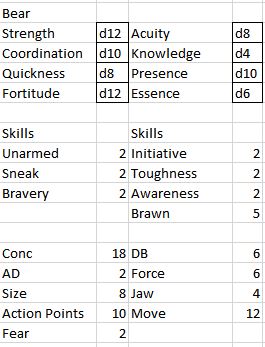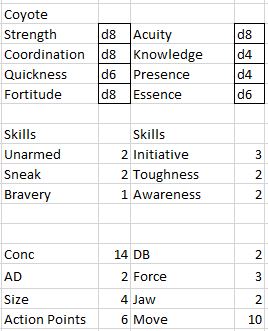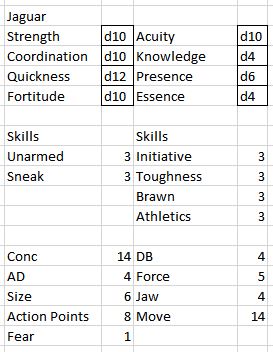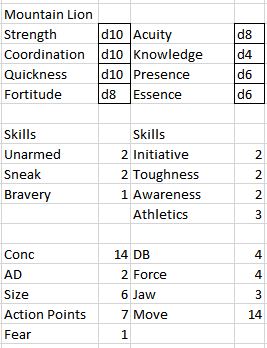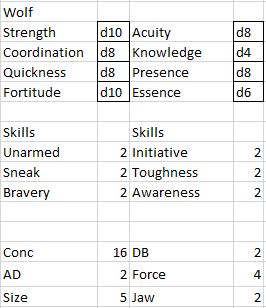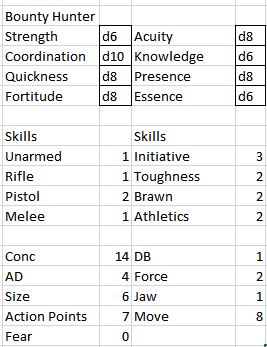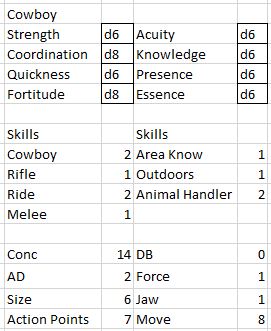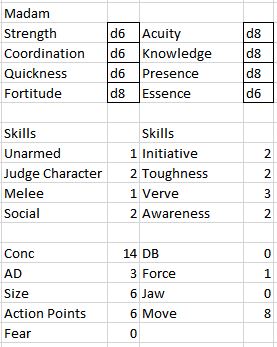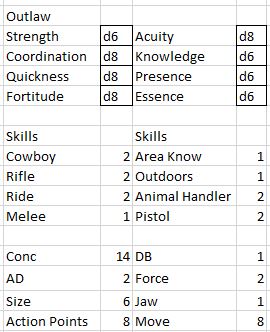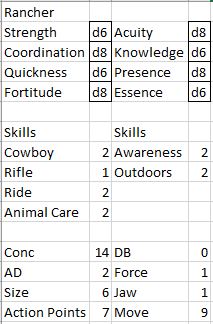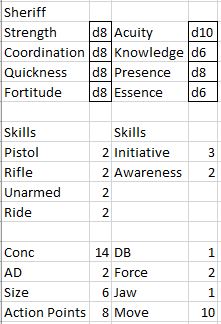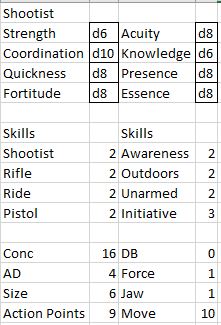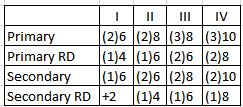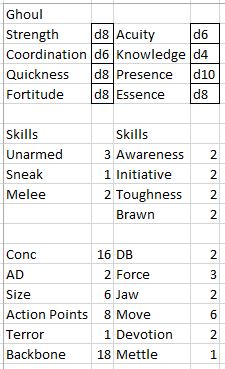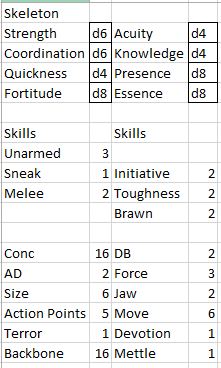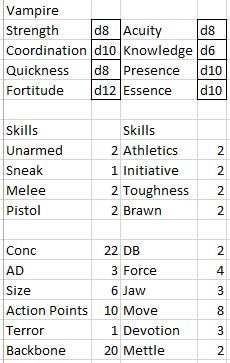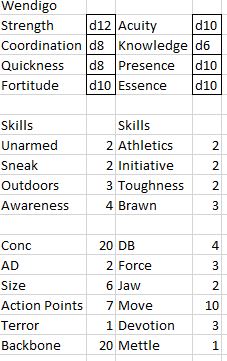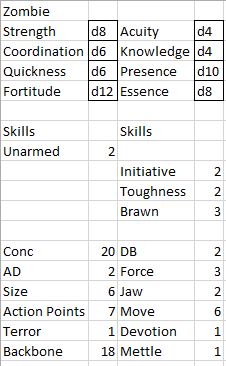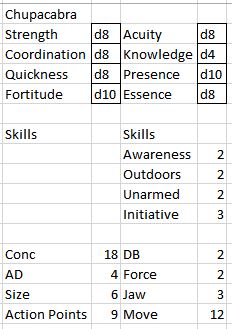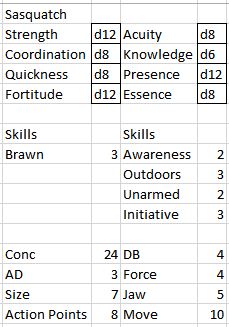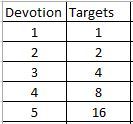Difference between revisions of "The West That Wasnt - Adversaries"
(→Chimeras and Other Constructs) |
(→Creating and Using Supernatural Abilities) |
||
| Line 201: | Line 201: | ||
=Creating and Using Supernatural Abilities= | =Creating and Using Supernatural Abilities= | ||
Supernatural entities are most interesting when unique to your story. To that end, the abilities that entities possess should be crafted to the story as well. Most supernatural abilities should be governed by the Essence trait. There are three skills that can be used to help simulate the effects needed: Devotion, Mastery and Power. | Supernatural entities are most interesting when unique to your story. To that end, the abilities that entities possess should be crafted to the story as well. Most supernatural abilities should be governed by the Essence trait. There are three skills that can be used to help simulate the effects needed: Devotion, Mastery and Power. | ||
| + | |||
| + | Opening these skills to the Posse can change the tone of the campaign greatly. When the players can cow or otherwise shun the supernatural the enemies become just another puzzle to solve. | ||
==Devotion== | ==Devotion== | ||
Revision as of 15:00, 13 July 2020
The West is home to all manner of critters and varmints, as well as men and women from all walks of life. The bestiary contains Traits and Skills for a selection of them, both mundane and supernatural, should your game take a turn in that direction. Rather than listing a roster of enemies and their traits, we instead provide some example entities and building blocks so that a Judge can create unique adversaries to fit their story.
Each entry has a set of traits followed by important skills or attributes. If a Trait Skill is not listed, it is assumed to be 1. If a regular skill is not listed, it is not possessed. Creatures of Size 8 or greater cause Fear when within a single move (a number of Paces equal to their Move value).
Animals deal damage in combat based on their size and the following table:
Animal bites are deadly attacks. Most animal claws are impact attacks, subject to Judge discretion (exceptionally long or sharp claws should be deadly). Most animals that have claws begin a fight with claw attacks, attempting to slow their foe enough to allow for an effective bite. Bite attacks are -2 unless it is the only form of attack for the creature. The Force and DB values listed apply to impact attacks, not deadly ones.
Contents
The Mundane
The West is populated by both animals and human beings of all types. Some common examples are listed here for reference. The animals provided combined with the animal attacks table should allow easy creation of new creatures as needed.
Animals of the West
The north American bear is one of the deadliest animals in the wilds anywhere in the world. Stats given are for a typical brown or black bear, but larger and more powerful examples certainly exist, with size 9 or even 10, and DB up to 10. Bears have claw and bite attacks.
Wild boars are one of the most widely disbursed animals on earth. Though attacks on humans are rare, they are not unheard of especially during the rutting season. Boar tusks are deadly attacks.
Coyotes are small predators, operating either individually or in packs. The coyote is common in indigenous American folklore, often occurring as a trickster. Coyotes generally hunt larger prey in pairs or groups, while smaller prey is caught by individuals. Coyotes have bite attacks.
Jaguars are the largest feline in the Americas, often 100-150kg. They are the premier stalk and ambush predator in the wild, capable of great patience and stealth and great bursts of strength and speed. Though formidable, jaguars avoid contact with humans and will only attack when cornered or otherwise given no alternative. Jaguars have both claw and bite attacks.
Mountain lions, or cougars, are large, wide ranging feline predators. Cougars are solitary and nocturnal, and are rarely seen during daylight hours. They hunt from ambush, but avoids humans and will yield prey to larger predators such as bears or jaguars. Mountain Lions have claw and bite attacks.
Wolves are large, pack hunting predators. Wolves have bite attacks.
Citizens of the West
Every city, town, farmstead and ranch is (or was) inhabited by someone. Sometimes a posse needs to interact with them. The following stock NPCs can suffice when a full character is not available.
Every saloon, or bar and grill, needs a doorman to keep the rowdiest violence outside.
The law is very localized in the West, and bounty hunters provide a vital service tracking down outlaws and fugitives while local lawmen keep the peace at home.
Cowboys are one of the most common occupations in the West. Many a man, and woman for that matter, makes their livelihood driving and caring for cattle across the vast expanses of the western landscape.
Ladies of the evening are as common as the cowboys that visit them, and someone has to handle their business dealings.
As with cowboys, outlaws are very common in the West. Many a man and woman make their living from greed and force of arms.
A rancher is someone who owns a ranch or farmstead. They are vital to the economy, providing jobs for cowboys and sometimes shootists.
The local sheriff is the law in many a town of the West.
Shootists are men or women who make their living as hired guns, either as bouncers, security or murder-for-hire.
The Supernatural
Supernatural enemies are often unique to a particular locale or story. The profiles that follow are examples of scourges that may infest the West and is not intended to be exhaustive. The profiles that follow can be used in combination with the attacks table to create the right supernatural enemies for your story.
Supernatural creatures may have many different types of attacks. The physical attacks are classified on the following table:
The primary attack is the preferred attack method for the entity. Some entities may have multiple secondary attack types. Like with animals, bite attacks are -2.
Using Supernatural Enemies
Each type of enemy that is listed below has adventure seeds that describe one way that it could be used. The Judge is likely to tailor the skills and abilities of the creature to the scenario at hand, so do not assume that what follows is what exists in your game.
Humanoid Supernatural Entities
The following supernatural creatures are derived from humans. Many are known as the undead, because they were once alive, and also once dead, but now exist in a state that is truly neither.
Ghoul
Ghouls are undead that subsist on the flesh of the living or recently deceased. Because they consume the soul through consumption of the body, they prefer victims they have personally killed. Most ghouls cannot gain nourishment from bodies that have been dead longer than a day or so.
Ghouls look like living humans, except that their skin is ashy grey, and their hair is stringy and thin, often falling out. They may have sores or other blemishes as well depending on their age. Young ghouls can pass for human for short periods.
Ghoul claws (Primary, Class I) and bites (Class I) are deadly. Ghouls can also use standard humanoid hand-to-hand attacks and defenses.
Ghoul Adventure Seeds
First it was livestock, then some of the locals disappeared. Old man Lanigan has been acting strange since his return from the latest gold prospecting expedition. The locals are concerned for him, until a kid disappears near his farmstead...
Skeleton
Skeletons are the animated corpses of the long-dead. They are automatons that must be controlled by another entity. Because of their lack of flesh, skeletons are very hard to damage with most firearms. To simulate this, they have an AV of 3 versus firearms except shotguns, against which they have an AV of 1. Any damage that does not cause a wound is ignored.
Skeleton claws (Primary, Class I) are deadly. Skeletons have no secondary attack.
Skeleton Adventure Seeds
The border dispute between the Double X and Bar T ranches is beginning to get out of hand. The sheriff has visited both ranches frequently over the last month, and their disputes have spilled over into the town. Then one day the cowboys from the Bar T stopped coming to town. A concerned deputy returns from a welfare check with some grave news: all of them are dead. What is more concerning is most of them are face down, as if running away, with giant scratch marks on their backs. On a seemingly unrelated note, someone has vandalized the local boot hill. Scores of old grave sites are busted open, the bodies seem to be missing...
Vampire
Vampires subsist on the souls of the living by consuming their blood and life force. Depending on the origin of the vampire their method of subsistence and procreation may vary, as well as their appearance. Vampires that look human do not cause Terror unless they spend an action (4 AP) to do so. Vampires have 2 AV versus all deadly attacks. Vampire bites are deadly.
Some vampires are solely creatures of the night, while others may exist during daylight as well. Those who look human may have an occupation and a full character sheet of skills. Vampires make excellent story enemies because of their resilience and breadth.
Vampire lore includes many variations. Some may take on beast forms, or have the ability to otherwise alter their appearance. The vampire stats listed here are for an individual that has assimilated into human culture.
Vampire claws (Secondary, Class I) and bites (Primary, Class II) are deadly. Vampires are capable of the standard hand-to-hand attacks and defenses as well. Though their bite is their preferred attack form, vampires are intelligent and will use their claws or other hand-to-hand attacks to immobilize their prey before attempting a bite. Vampires have access to standard hand-to-hand attacks as well as their supernatural abilities.
Vampire Adventure Seeds
The town of McKinley Bluff is a quiet hamlet miles from the nearest settlement. A few months back, the daughter of a local businessman ran away, and the bounty hunter he hired tracked her there. The last correspondence from him was weeks back, and he had promised to write as soon as he arrived. Concerned, he hires a new group to follow up on the lead. As with the first expedition, no word arrives after they arrive in town. The Posse is his last hope. Upon arriving in town, the first thing they notice is how strangely devoted the townsfolk are to the mayor, Charles McKinley. Surely a meeting with him at his manor house will clear everything up in a jiffy!
Wendigo
The Wendigo is a staple of indigenous American folklore, often appearing as a gaunt, tall man. They are cannibalistic, and have an insatiable desire for flesh. In some legends the Wendigo grows taller after consuming prey, but it maintains the sickly and thin physique.
Many legends also indicate that the Wendigo has power over the winter storm, and will use this to advantage. Some also indicate that they have spirit forms as well as physical, which can make them extremely formidable.
Though the Wendigo is a northeastern legend, there is no reason the belief could not spread to the West, especially into the harsh winters of the Rockies where the spirit itself would feel right at home.
Wendigo Adventure Seeds
Jock Curtis was always a willful man, so when he refused to listen to reason and insisted on making a trek through the pass in the dead of winter, it was business as usual. And, though saddened, no one was all that surprised when he failed to make it to the next town. At the spring thaw his wagon and the carcass of his horse, or what was left of it, was found, but there was no sign of old Jock. Lately, travelers have been reporting a strange sensation of being watched, and some have even seen a strange figure lurking near the tree line. Then one day, surprising news from back east: Jock Curtis has inherited a fortune. Proof of his demise must be secured so his sister can claim his half. Surely, some trace of him still sits on trail. Finding it should be a simple matter...
Zombie
Zombies are the animated corpses of individuals that have not yet decomposed to the point of a skeleton. Like skeletons, they must be controlled by an external entity, however in many cases they may be capable of following simple directions. Zombies can regenerate at a rate of one wound per minute unless their head is destroyed (5 wounds).
Alternatively, zombies may be autonomous, but single minded, creatures obsessed with consuming the living or proliferation of their kind.
Zombie bites (Class I) are deadly. Zombies are also capable of punch (quick attack) and hold (standard) attacks. For a hold attack, if the zombie achieves partial or full dominance their next attack will be a bite.
Zombie Adventure Seeds
No one has heard from the Davidson homestead for weeks. The last news was that the young daughter was sick with a nasty flu, and doc Anderson went out to check on them. That was 10 days ago, and he has not returned. Today a traveler said he saw something strange at their house, and he also said it looked like all of their livestock were dead. Someone has to go see what is happening out there.
Monstrous Supernatural Entities
Chupacabra
The chupacabra is a legendary Latin American cryptid, rumored to attack and exsanguinate livestock of all sizes, but especially goats. The word literally means "goat-sucker". The chupacabra vary in size from 5-7, or perhaps even larger. The chupacabra is a solitary hunter, stealthy and savage. While they are not known to attack humans often, if cornered they may out of self preservation.
Chupacabra have class I claws and class II bite. Their backs are adorned with a spiny mane, which inflicts class I damage on any individual unlucky enough to grab it or otherwise be impaled by them.
Sasquatch
Sasquatch is the legendary giant humanoid that lives in the mountains and forests of the northwest. They are known to be very reclusive, and generally shun contact with humans. Most reports describe them as nocturnal and bipedal, resembling an upright silverback.
The sasquatch has class II punch and class II bite, with the punch the preferred method of immobilizing foes before devouring them.
Spirits and Hauntings
Incorporeal entities pose a unique challenge because of their intangible existence. Normally, bullets and blades have little to no effect on them. This wrinkle can make them extremely challenging as adversaries. There are many solutions to this problem, depending on your story.
1. A devout priest or shaman could bless weapons (or the Posse itself) to make them viable against the foes. This is the simplest (and arguably least interesting) option, but it can still be part of an exciting and challenging story. Finding the right devotee and providing him or her with the necessary trappings for the ritual can be a full adventure in itself.
2. A benevolent spirit may require some wrong to be righted or otherwise provide an appropriate quest to allow the haunting to subside. This sort of endeavor could prove quite challenging if the spirit itself has requirements for how the steps must be performed. For example, it may require that no one learn of the initial wrongdoing (or that everyone does!), or that no one be killed or harmed in service of the spirit itself.
3. A malevolent spirit may need to be banished in some way. This could include locating the physical remains and destroying it, potentially in some ritualistic manner.
The possibilities are nearly endless. Hauntings can be a nice change of pace for a Posse that has solved many a problem with quick and steady gun hands.
Chimeras and Other Constructs
Another interesting type of adversary is the constructed being. The construct itself is not the mastermind, so such a scenario involves defeating the construct(s) and finding and defeating the madman behind its creation.
Chimeras could be created from two (or more) live animals, or they could be dead animals combined and somehow brought back to life. Chimeras are chaotic and unpredictable in nature, due to the multiple types of creatures fighting to exist within the same body.
Constructs are created from multiple dead bodies to form a single, new whole. The Frankenstein monster is an example of a construct. Constructs are physically powerful, but mentally weak, and require direction from an outside source.
Cults and Cabals
When mundane individuals unite in service of a supernatural entity or belief system, the cult created can be a flexible and challenging set of adversaries. Cults are by their very nature secretive, and their ability to remain faceless is key to their strength.
Cult members, and especially their leaders, are often upstanding citizens who wield considerable power be it supernatural or political. Their plans often involve laying the blame on the innocent and powerless. Cults offer the opportunity to have a mix of enemy types, from gun hands to mystics with power over the supernatural. Dealing with a well organized cult can offer escalating and diverse challenges throughout a campaign arc.
Alternatively, a cult may be composed of the marginalized members of society, such as a disenfranchised indigenous tribe or a collection of Chinese railroad workers. In this case, secrecy is even more important since they are not able to wield any power in the mundane world to deflect blame when suspicion rears its head. The legends of those cultures offer rich troves of inspiration for supernatural entities a cult could serve.
Masterminds in Supernatural Stories
Supernatural stories offer the opportunity for a great variety of masterminds and villains. The mastermind could be a supernatural entity in and of itself, such as a vampire using preternatural charm and otherworldly abilities to control the local populace, or possibly using other means to control lesser supernatural creatures such as skeletons or zombies as well. Alternatively, a mastermind could be a simple man (or woman) of science who finds the key to creating life, and brings the undead to bear against anyone who dares stand in their way.
It matters little whether the enemy is supernatural in origin, what will make all the difference is ensuring that the enemy is dynamic and motivated. The Posse should understand, perhaps even sympathize with, the motivations of any good enemy. That will not stop them from foiling the evil plans, it will instead make the interaction richer and more interesting.
For example, a woman who lost her husband and son during an ill-timed mountain trek might somehow receive a flash of insight while shivering in the treacherous cold. Suddenly she sees how she can again have her beloved family at her side, and somehow finds a way to traverse the winter doom that is the pass. Miraculously, she is found near death by an old prospector who nurses her to health and accompanies her to the nearest town. Little by little she tests her hypotheses until she is able to animate the corpse of a dire wolf. She and the wolf return to the pass and find her loved ones, but important parts of her dead family have been scattered by predators. Now, back in town, she knows she will need fresh corpses with the traits her loved ones possessed if she is to successfully return them to her. She sets her sights on the head of one man, the arms of another, and the body and legs of still another. Piece by piece, she begins acquiring the building blocks she needs to reunite her family...this time forever.
A villain such as that is both monstrous and pitiable. Moreover, is it madness, or true insight driving her? Maybe the wolf was never dead and she is little more than a deranged killer. No matter what the solution, a mastermind such as this is memorable and engaging.
Creating and Using Supernatural Abilities
Supernatural entities are most interesting when unique to your story. To that end, the abilities that entities possess should be crafted to the story as well. Most supernatural abilities should be governed by the Essence trait. There are three skills that can be used to help simulate the effects needed: Devotion, Mastery and Power.
Opening these skills to the Posse can change the tone of the campaign greatly. When the players can cow or otherwise shun the supernatural the enemies become just another puzzle to solve.
Devotion
Devotion is conviction in the face of adversity. It can be used by holy men and women to combat the supernatural, and also by supernatural entities to resist those efforts. For a supernatural entity, Devotion is the strength of their very existence.
Using Devotion
Devotion can be used "offensively" to banish or otherwise cow certain supernatural entities. Whether or not an entity is subject to this effect is up to the Judge, and depends on the origin of the entity itself. Characters with a Devotion of at least 1 and the Religious Conviction Perk may attempt to affect a number of entities according to the following table:
Using this ability costs 4 AP, and the character is considered prone for targeting purposes. The character must have an appropriate religious symbol or totem to make the attempt. During the turn the character focuses their religious conviction toward the creature(s). The TN is 4+(target's Devotion). Success causes the creature to stop what it is doing and retreat for as long as the character maintains the action. All attacks versus the retreating creatures are at +1. A bump causes the creature to instead freeze in place, being treated as prone for targeting purposes. Second and subsequent bumps also cause fear damage to the creature. Treat the character's Devotion level as their Fear level, and resolve an attack versus the creature's Backbone. A creature reduced to 0 Backbone in this manner is banished (it ceases to exist).
To maintain a banishment attempt a character must pay 4 AP each round, and continues to be considered prone for targeting purposes. The TN to maintain the attempt is 5. If the character was the target of any attacks since the initial action, they must first test Bravery to see if the attempt is broken. The character is subject to the rules presented in Chapter 4 - Combat Actions - Tactical Aiming. If their Bravery is at least 1 they may substitute their Devotion for Bravery when testing to see if the attempt is maintained.
Mastery
Mastery is the ability of an entity to control other entities. Normally, the controlled beings are automatons, but entities with very high Mastery can control willful characters (non-automaton NPCs) as well. The TN to control automatons is based on the Devotion of the automatons and the number of them. The base TN is 3 plus the half Devotion level, rounded up, +1 additional per doubling of their number. For example, if a vampire wanted to control 5 Devotion 1 skeletons, the TN would be 6 (3 +1 for Devotion, +2 for 4-7 entities). Mastery checks are made when new directives are to be substituted for previous ones. When unsuccessful, the automatons continue doing what they were previously. On a critical failure, a new directive is implanted that is opposite (or significantly removed from) what was intended.
Controlling willful characters is significantly more difficult. The TN to control a willful NPC is 3 plus the rank of their Spirit trait, plus any Devotion levels they have. Thus to control a priest with Spirit 3 and Devotion 3 would be TN 9.
Controlling a Hero is a game unto itself, with difficulty determined by the player's choices. The base TN to control a Hero is 5 + (Spirit or Devotion rank). Determining the action is a three step process:
1. Judge narrates what the being attempting the control wishes the Hero to do.
2. Player narrates what they wish to do instead.
3. Card is drawn to determine which occurs. On a success, the intended action occurs, on a failure, the player's response occurs instead.
The difficulty of the check is adjusted based on the difference between the actions narrated by the two sides. The closer the action chosen by the player is to the intent of the villain, the greater the increase in the TN. In other words, when a player attempts to do something close to the intent of the enemy, it is more likely that the player will be successful. When the player's action is diametrically opposed to the intent, the TN is unchanged, or even lowered by 1 or 2. When the action preserves some of the intent, add 1-2 to the TN. When it preserves virtually all of it, add 3-4.
For example, Cyril, Miranda and Hank are traveling with a deputy when they come upon a solitary rider, who turns out to be a vampire. At an opportune moment (for him), the vampire commands Cyril to turn and shoot Miranda. If Cyril declares:
I will shoot the vampire instead - TN-1
I will draw my weapon and point it at Miranda, but not shoot - TN-0
I will fire at Miranda, but deliberately miss - TN+1
I will fire at the deputy instead - TN+2
I will fire at Miranda's mount - TN+3
The goal of the system is to give the player some narrative control over how the story unfolds, even when an adversary is able to take control of a character. By incentivizing choosing something closer to the intent of the acting entity, players are able to maintain some control while still choosing to do something that they would not normally choose. In effect, the player and Judge agree on how the enemy can influence the character.
Power
Power is the ability of a supernatural entity to utilize a supernatural power. The skill is unique for each power. For example, a vampire might have the ability to transform into a bat, wolf or mist. This would be a single power, with different TN for each form (e.g. TN 5 for wolf, 7 for bat, 9 for mist). Another example could be the werewolf, and it's ability to howl at the moon and draw wolves to their aid. Powers need not be traditional; the possibilities are nearly endless.
Generally, the more suspension of disbelief, the higher the TN. In the vampiric transformation example above, the wolf form is the easiest because it is the closest to the human form in size and shape, whereas changing into a mist requires becoming nearly intangible so it is the hardest. An "average" use of a power has a TN of 5, with more difficult abilities being 7, 9 or more. Not all powers have multiple incarnations.
